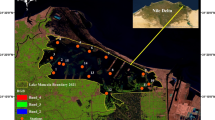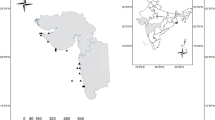Abstract
Lakes are functionally integral and biologically complex freshwater ecosystems which provide a vast array of ecosystem goods and services to society. Nowadays aquatic ecosystems are being used, misused and abused by diverse anthropogenic activities at an unprecedented rate. The management of lake water quality is usually directed to resolution of conflicts between maintenance of desirable water quality and human-induced degradation of aquatic environment. Nutrients play a decisive role in determining lake’s environmental state through regulation of its primary production. The present study on Saheb Bundh Lake located in Purulia District, West Bengal, India, was undertaken to assess the status of nutrients (nitrogen and phosphorus) subject to certain anthropogenic activities, and to construct models using best subset method which could be adopted as a nutrient management tool. The water samples were monitored for different physicochemical parameters adopting standard methods. It was found that the set of variables including turbidity, temperature, pH, redox potential and total hardness has been championed as the best subset of water quality explaining the dynamics of total phosphorus concentration of freshwater Saheb Bundh Lake. The suite of factors comprising dissolved oxygen, pH, temperature, turbidity and total hardness has been proved as the best subset for estimating total nitrogen concentration. The models developed have been validated for total phosphorus and total nitrogen concentration. For total phosphorus, the model values were found to be very close to the measured values but the values varied widely for total nitrogen, championing the former as a very potent down-to-earth model.



Similar content being viewed by others
References
An KG, Choi JW, Lee YJ (2013) Modifications of ecological trophic structures on chemical gradients in lotic ecosystems and their relations to stream ecosystem health. Anim Cells Syst 17:53–62
APHA (American Public Health Association, American Water Works Association and Water Pollution Control Federation) (1998) Standard methods for the examination of water and wastewater, 19th edn. American Public Health Association, New York, p 1038
Bellinger EG (1992) A key to common algae, freshwater and some coastal species, 4th edn. Institute of Water and Environmental Management, London
Bhatia KKS, Tyagi A, Sharma MK (1997) Groundwater conductivity modeling using best subset procedure, In: Proceeding of international symposium on emerging trends in hydrology, Department of Hydrology, University of Roorkee, Roorkee, 25–27 Sept, pp 41–53
Biggs BJ (2000) Eutrophication of streams and rivers: dissolved nutrient-chlorophyll relationships for benthic algae. J N Am Benthol Soc 19:17–31
Bostrom B, Andersen J, Fleischer S, Jansson M (1988) Exchange of phosphorus across the sediment–water interface. Hydrobiologia 170:229–244
Busenberg S, Kumar SK, Austin P, Wake G (1990) The dynamics of a model of plankton–nutrient interaction. Bull Math Biol 52:677–696
Chase JM, Ryberg WA (2004) Connectivity, scale-dependence, and the productivity–diversity relationship. Ecol Let 7:676–683
Chen Y, Zhang C, Gao X, Wang L (2012) Long-term variations of water quality in a reservoir in China. Water Sci Technol 65(8):1454–1460
Choi JW, Han JH, Park CS, Ko DG, Kang HI, Kim JY, Yun YJ, Kwon HH, An KG (2015) Nutrients and sestonic chlorophyll dynamics in Asian lotic ecosystems and ecological stream health in relation to land-use patterns and water chemistry. Ecol Eng 79:15–31
Deans CA, Behmer ST, Kay A, Voelz N (2014) The importance of dissolved N: P ratios on mayfly (baetis spp.) growth in high-nutrient detritus-based streams. Hydrobiologia 742:15–26
Dillon PJ, Rigler FH (1974) The phosphorus–chlorophyll relationship in lakes. Limnol Oceanogr 19(5):767–773
Dokulil MT, Donabaum K, Teubner K (2007) Modifications in phytoplankton size structure by environmental constraints induced by regime shifts in an urban lake. Hydrobiologia 578:59–63
Downing JA, Watson SB, McCauley E (2001) Predicting cyanobacteria dominance in lakes. Can J Fish Aquat Sci 58:1905–1908
Ghosh N (ed) (2007) Paschim Banga—Purulia district. Department of Information & Culture, Government of West Bengal, Kolkata
Guildford SJ, Hecky RE (2000) Total nitrogen, total phosphorus, and nutrient limitation in lakes and oceans: is there a common relationship? Limnol Oceanogr 45:1213–1223
Guildford SJ, Bootsma HA, Fee EJ, Hecky RE, Patterson G (2000) Phytoplankton nutrient status and mean water column irradiance in Lakes Malawi and Superior. Aquat Ecosyst Health Manag 3:35–45
Håkanson L, Bryhn AC, Hytteborn JK (2007) On the issue of limiting nutrient and predictions of cyanobacteria in aquatic systems. Sci Total Environ 379:89–108
Havens KE, Nürnberg GK (2004) The phosphorus–chlorophyll relationship in lakes: potential influences of colour and mixing regime. Lake Reserv Manag 20:188–196
Havens KE, James RT, East TL, Smith VH (2003) N: P ratios, light limitation, and cyanobacterial dominance in a subtropical lake impacted by nonpoint source nutrient pollution. Environ Pollut 122:379–390
Hecky RE (1998) Low N:P ratios and the nitrogen fix: why watershed nitrogen removal will not improve the Baltic. In: Kungl (ed) Effects of nitrogen in the aquatic environment, KVA Report 1998: 1. Vetenskapsakademien (Royal Swedish Academy of Sciences), Stockholm, pp 85–115
Hecky RE, Kilham P (1988) Nutrient limitation of phytoplankton production in freshwater and marine environments: a review of recent evidence on the effects of enrichment. Limnol Oceanogr 33:796–822
Hilt S (2015) Regime shifts between macrophytes and phytoplankton—concepts beyond shallow lakes, unravelling stabilizing mechanisms and practical consequences. Limnetica 34(2):467–480
Howarth RW (2003) Human acceleration of the nitrogen cycle: Drivers, consequences, and steps towards solutions. In: Choi E, Yun Z (eds) Proceedings of the strong N and agro 2003 IWA specialty symposium. Korea University, p 3–12
Ikeda S, Adachi N (1976) Dynamics of the nitrogen cycle in a lake and its stability. Ecol Model 2:213–234
James C, Fisher J, Russel V, Collings S, Moss B (2005) Nitrate availability and hydrophyte species richness in shallow lakes. Freshwater Biol 50:1049–1063
Jeppesen E, Sondergaard M, Jensen JP et al (2005a) Lake responses to reduced nutrient loading: an analysis of contemporary long-term data from 35 case studies. Freshwater Biol 50:1747–1771
Jeppesen E, Jensen JP, Søndergaard M, Lauridsen T (2005b) Response of fish and plankton to nutrient loading reduction in 8 shallow Danish lakes with special emphasis on seasonal dynamics. Freshwater Biol 50:1616–1627
Körner S (2002) Loss of submerged macrophytes in shallow lakes in north-eastern Germany. Int Rev Hydrobiol 87:375–384
Lee ZM, Steger L, Corman JR, Neveu M, Poret-Peterson AT, Souza V, Elser JJ (2015) Response of a stoichiometrically imbalanced ecosystem to manipulation of nutrient supplies and ratios. PLoS ONE. doi:10.1371/journal.pone.0123949
Lévêque C (2001) Lake and pond ecosystems. Encycl Biodivers 3:633–644
Matzinger A, Pieters R, Ashley KI, Lawrence GA, Wuest A (2007) Effects of impoundment on nutrient availability and productivity in lakes. Limnol Oceanogr 52(6):2629–2640
Moore PA Jr, Daniel TC, Edwards DR Jr (2000) Reducing phosphorus runoff and inhibiting ammonia loss from poultry manure with aluminum sulfate. J Environ Qual 29:37–49
Moosmann L, Gachter R, Muller B, Wuest A (2006) Is phosphorus retention in autochthonous lake sediments controlled by oxygen or phosphorus? Limnol Oceanogr 51(1):763–771
Phillips G, Pietila¨inen O-P, Carvalho L, Solimini A, Lyche Solheim A, Cardoso AC (2008) Chlorophyll–nutrient relationships of different lake types using a large European dataset. Aquat Ecol 42(2):213–226
Prepas EE, Bruke JM (1997) The effects of hypolimnetic oxygenation on water quality in Arnisk Lake, Alberta, a deep eutrophic lake with high internal phosphorus loading rates. Can J Fish Aquat Sci 54:2111–2120
Redfield A (1958) The biological control of chemical factors in the environment. Am Sci 46:205–221
Schallenberg M, de Winton MD, Verburg P, Kelly DJ, Hamill KD, Hamilton DP (2013) Ecosystem services of lakes. In: Dymond JR (ed) Ecosystem services in New Zealand—conditions and trends. Manaaki Whenua Press, Lincoln
Scheffer M, Van Nes EH (2007) Shallow lakes theory revisited: various alternative regimes. Hydrobiologia 84:455–466
Scheffer M, Carpenter SR, Foley JA, Folke C, Walker B (2001) Catastrophic shifts in ecosystems. Nature 413:591–596
Schlesinger WH (1991) Biogeochemistry: an analysis of global change. Academic Press Inc., Millbrae, p 351
Sharma MK, Jain CK (2005) Fluoride modeling using best subset procedure. J Appl Hydrol 18:12–22
Shukla JB, Misra AK, Chandra P (2008) Modeling and analysis of the algal bloom in a lake caused by discharge of nutrients. Appl Math Comput 196:782–790
Sinke AJC, Cappenberg ThE (1988) Influence of bacterial processes on the phosphorus release in the eutrophic Loosdrecht lakes, The Netherlands. Arch Hydrobiol Beih 30:5–13
Smith V (1983) Low nitrogen to phosphorus ratios favor dominance by blue-green algae in lake phytoplankton. Science 221:669–671
Smith VH, Tilman GD, Nekola JC (1999) Eutrophication: impacts of excess nutrient inputs on freshwater, marine, and terrestrial ecosystems. Environ Pollut 100:179–196
Stelzer RS, Lamberti GA (2001) Effects of N: P ratio and total nutrient concentration on stream periphyton community structure, biomass, and elemental composition. Limnol Oceanogr 46:356–367
Tran CP, Bode RW, Smith AJ, Kleppel GS (2010) Land-use proximity as a basis for assessing stream water quality in New York State (USA). Ecol Indic 10:727–733
Vitousek PM, Mooney HA, Lubchenco J, Melilo JM (1997) Human domination of Earth’s ecosystems. Science 277:494–499
Voinov AA, Tonkikh AP (1987) Quantitative model of eutrophication in macrophyte lakes. Ecol Model 35:211–226
Volk C, Kiffney P (2012) Comparison of fatty acids and elemental nutrients in periphyton, invertebrates, and cutthroat trout (Oncorhynchus clarki) in conifer and alder streams of western Washington State. Aquat Ecol 46:85–99
Vollenweider RA (1968). Scientific fundamentals of the Eutrophication of lakes and flowing waters, with particular reference to nitrogen and phosphorus as factors in Eutrophication. Paris, Rep. Organization for Economic Cooperation and Development, DAS/CSI/68.27, p 192
Wanga Y, Zhang J, Konga H, Inamoric Y, Xud K, Inamoric R, Kondod T (2009) A simulation model of nitrogen transformation in reed constructed wetlands. Desalination 235:93–101
Weisberg S (2005) Applied linear regression, 3rd edn. Wiley, New York
Yun Y-J, An K-G (2016) Roles of N: P ratios on trophic structures and ecological stream health in lotic ecosystems. Water 8(22). doi:10.3390/w8010022
Zhang C, Liu H, Gao X, Zhang H (2016) Modeling nutrients, oxygen and critical phosphorus loading in a shallow reservoir in China with a coupled water quality—macrophytes model. Ecol Indic 66:212–219
Acknowledgements
The authors gratefully acknowledge the infrastructural support extended by the University of Kalyani and St. Joseph’s College (Univ. Section), Darjeeling. Acknowledgement is also due to Professor Chandranath Pal, Department of Statistics, University of Kalyani, for his valuable suggestion.
Author information
Authors and Affiliations
Corresponding author
Ethics declarations
Conflict of interest
It is declared that the authors have no conflict of interest.
Additional information
Editorial responsibility: An-Lei Wei.
Rights and permissions
About this article
Cite this article
Biswas, J.K., Bera, B., Chanda, R. et al. Nutrient modeling of an urban lake using best subset method. Int. J. Environ. Sci. Technol. 15, 1867–1878 (2018). https://doi.org/10.1007/s13762-017-1540-7
Received:
Revised:
Accepted:
Published:
Issue Date:
DOI: https://doi.org/10.1007/s13762-017-1540-7




